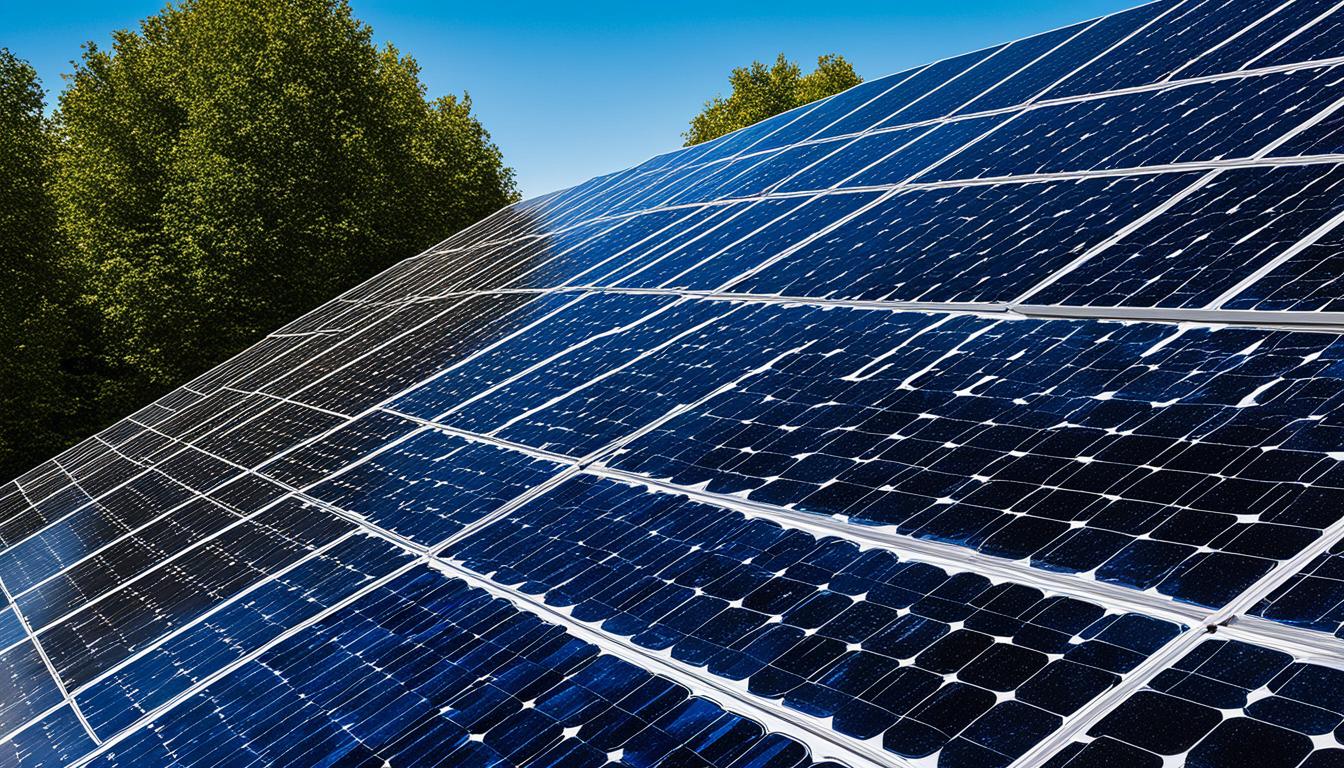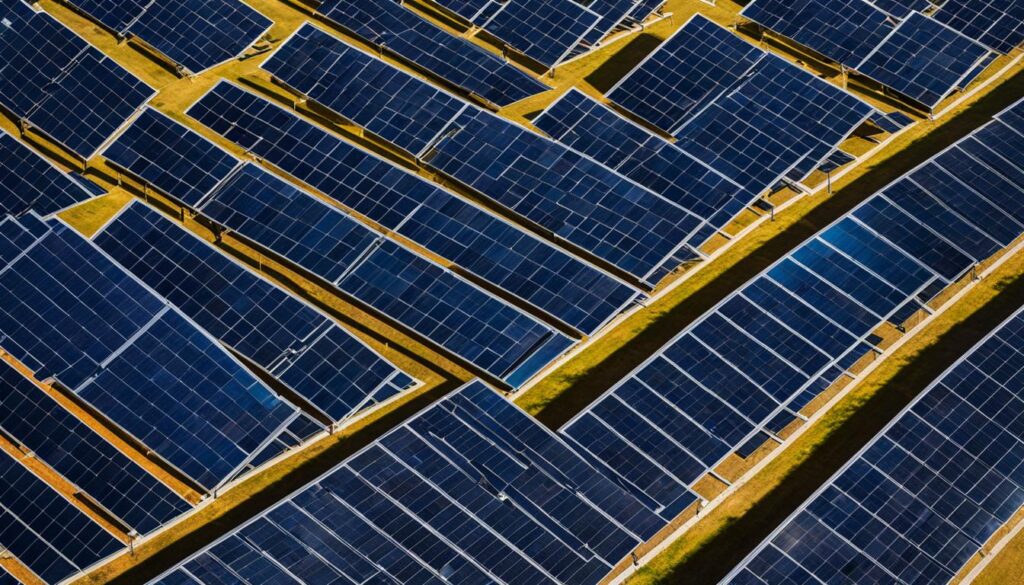
Welcome to my article where we’ll dive into the efficiency battle between monocrystalline and polycrystalline solar panels, helping you determine the best option to power your home. With the increasing popularity of solar energy, it’s essential to choose the right panels that not only provide clean and renewable energy but also maximize efficiency.
Monocrystalline and polycrystalline solar panels are two popular choices for residential installations. While both have their advantages and disadvantages, homeowners often consider efficiency as a crucial factor in making the right decision. In this article, we’ll compare the efficiency of these panels, giving you the insights needed to make an informed choice for your home.
Key Takeaways:
- The efficiency of monocrystalline solar panels is generally higher due to their single crystal structure.
- Polycrystalline solar panels have a slightly lower efficiency compared to monocrystalline panels due to their multiple crystal structures.
- Factors such as temperature, shading, and panel orientation can impact overall efficiency, regardless of panel type.
- When choosing between the two, consider factors like budget, available space, and specific installation requirements.
- Consulting with a solar professional can help determine the most suitable option for your home’s energy needs.
Understanding Monocrystalline Solar Panels
Monocrystalline solar panels are a popular choice for homeowners looking to harness the power of the sun. These panels are constructed using a single crystal structure, typically made of silicon. The utilization of a single crystal structure provides several advantages, including enhanced efficiency.
With their uniform crystal structure, monocrystalline solar panels allow electrons to flow more freely, resulting in higher conversion efficiencies. This means that monocrystalline panels can generate more electricity from the same amount of sunlight compared to other types of solar panels.
| Advantages of Monocrystalline Solar Panels | Disadvantages of Monocrystalline Solar Panels |
|---|---|
|
|
The efficiency of monocrystalline solar panels typically ranges from 15% to 22%, depending on the specific model and manufacturer. This means that these panels can effectively convert 15% to 22% of the sunlight they receive into usable electricity. Higher efficiency allows homeowners to maximize the power generated from their solar panels and ultimately reduce their reliance on the grid.
Monocrystalline solar panels offer an impressive combination of efficiency and performance. Their single crystal structure ensures a high level of electrical conductivity, enabling them to generate more power from the same amount of sunlight. This makes them an excellent choice for homeowners looking to maximize their solar energy output.
Unlocking the Power of Efficiency
The efficiency of monocrystalline solar panels is primarily attributed to their single crystal structure. The uniformity of the crystal lattice enables a higher level of electrical conductivity, reducing energy loss and maximizing power conversion. With their impressive efficiency, monocrystalline solar panels stand out as a reliable and cost-effective solution for residential solar installations.
Examining Polycrystalline Solar Panels
When it comes to solar panels, polycrystalline solar panels are a popular choice due to their affordability and durability. These panels are made from multiple crystal structures, giving them a unique appearance compared to their monocrystalline counterparts. However, their efficiency is slightly lower than that of monocrystalline solar panels.
One of the reasons for the lower efficiency of polycrystalline panels is their multiple crystal structure. Unlike monocrystalline panels, which are made from a single crystal structure, polycrystalline panels have crystals that are less uniform. This lack of uniformity affects the flow of electrons, resulting in a slightly lower efficiency.
The efficiency of polycrystalline solar panels typically ranges from 13% to 16%. While this is lower than the efficiency of monocrystalline panels, it is still a respectable level of efficiency that can effectively power residential homes.
The Advantages of Polycrystalline Solar Panels:
- Affordability: Polycrystalline panels are generally more affordable compared to monocrystalline panels, making them an attractive option for homeowners on a budget.
- Durability: Polycrystalline panels are known for their durability and resistance to extreme weather conditions, ensuring a long lifespan and reliable performance.
- Efficiency in real-world conditions: While the efficiency of polycrystalline panels may be slightly lower in ideal laboratory conditions, they can still perform well in real-world scenarios where shading and temperature variations are common.
Overall, polycrystalline solar panels offer a cost-effective and reliable option for homeowners looking to invest in solar energy. While their efficiency may not be as high as monocrystalline panels, they still provide a significant amount of energy and contribute to reducing carbon emissions.

Expert Quote:
“Polycrystalline solar panels are a practical choice for homeowners who want to maximize the value of their investment. While the efficiency may be slightly lower, the cost-effectiveness and durability make them a popular option in the residential solar market.” – Solar Energy Expert
Factors Affecting Efficiency
When comparing monocrystalline and polycrystalline solar panels, it’s crucial to consider factors that can impact their overall efficiency. While efficiency is an important consideration, other elements such as temperature, shading, and panel orientation can significantly influence the performance and effectiveness of the panels in harnessing solar energy.
Temperature: Solar panel efficiency is inversely related to temperature. Higher temperatures can reduce the efficiency of solar panels, resulting in decreased power output. It’s essential to account for temperature variations in your location and choose panels that are designed to perform well in warm climates.
Shading: Shading on solar panels can have a significant impact on their efficiency. Even partial shading, whether caused by trees, buildings, or other obstructions, can lead to a decrease in energy production. To maximize efficiency, it’s important to install solar panels in areas with minimal shading or use shading mitigation techniques such as panel tilting or bypass diodes.
Panel Orientation: The orientation of solar panels plays a crucial role in their efficiency. Panels should ideally face south (in the Northern Hemisphere) to capture the maximum amount of sunlight throughout the day. Deviations from the optimal orientation can reduce the overall energy production of the panels.
Considering these factors alongside efficiency allows homeowners to make a more informed decision when choosing between monocrystalline and polycrystalline solar panels.
Factors Affecting Efficiency Comparison
| Factors | Monocrystalline Panels | Polycrystalline Panels |
|---|---|---|
| Temperature | Perform well in high temperatures | Slightly lower performance in high temperatures |
| Shading | More sensitive to shading | Tolerate partial shading better |
| Panel Orientation | Require optimal orientation | More forgiving with orientation |
By considering these factors, homeowners can make a more comprehensive evaluation of the suitability of monocrystalline and polycrystalline solar panels for their specific needs and circumstances.

Conclusion
In conclusion, when comparing monocrystalline and polycrystalline solar panels, it’s clear that monocrystalline panels generally offer higher efficiency. However, it’s important to note that the difference in efficiency may not be significant for every homeowner.
Aside from efficiency, there are other crucial factors that should be considered when choosing the best option for powering your home with solar energy. These factors include your budget, the available space for installation, and specific requirements unique to your home.
To make an informed decision, I recommend consulting with a solar professional who can evaluate your individual needs and circumstances. They will be able to guide you in determining the most suitable choice for your home, ensuring that you maximize the benefits of solar power.
FAQ
What are monocrystalline solar panels?
Monocrystalline solar panels are made from a single crystal structure, usually silicon. The uniformity of the crystal structure allows electrons to flow more freely, resulting in higher efficiency.
What are polycrystalline solar panels?
Polycrystalline solar panels are made from multiple crystal structures, which are less uniform than monocrystalline panels. Due to their lower purity, polycrystalline panels have slightly lower efficiency compared to monocrystalline panels.
Which type of solar panel is more efficient?
Monocrystalline solar panels generally have higher efficiency than polycrystalline panels. Monocrystalline panels typically have conversion efficiencies ranging from 15% to 22%, while polycrystalline panels have efficiencies ranging from 13% to 16%.
What factors can affect the efficiency of solar panels?
Other factors that can affect the overall performance of the panels include temperature, shading, and panel orientation. It’s important to consider these factors in addition to efficiency when making your decision.
How do I choose between monocrystalline and polycrystalline solar panels?
The choice between monocrystalline and polycrystalline solar panels depends on factors such as budget, available space, and specific installation requirements. It is recommended to consult with a solar professional to determine the most suitable choice for your needs and circumstances.








